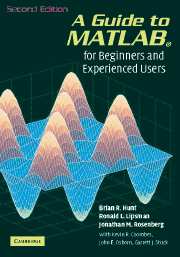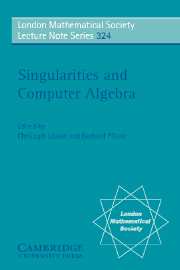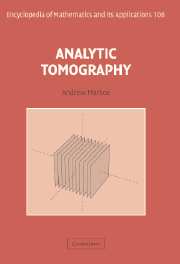Brian R. Hunt / Ronald L. Lipsman / Jonathan M. Rosenberg
University of Maryland, College Park
Kevin R. Coombes / University of Texas
John E. Osborn / University of Maryland
A Guide to MATLAB For Beginners and Experienced Users 2nd Edition
 Hardback (ISBN-13: 9780521850681 | ISBN-10: 0521850681)
Hardback (ISBN-13: 9780521850681 | ISBN-10: 0521850681)
Paperback (ISBN-13: 9780521615655 | ISBN-10: 0521615658
available from March 2006
This is a short, focused introduction to MATLAB, a comprehensive
software system for mathematical and technical computing. It
contains concise explanations of essential MATLAB commands, as
well as easily understood instructions for using MATLAB's
programming features, graphical capabilities, simulation models,
and rich desktop interface. Written for MATLAB 7, it can also be
used with earlier (and later) versions of MATLAB. This book
teaches how to graph functions, solve equations, manipulate
images, and much more. It contains explicit instructions for
using MATLAB's companion software, Simulink, which allows
graphical models to be built for dynamical systems. MATLAB's new
"publish" feature is discussed, which allows
mathematical computations to be combined with text and graphics,
to produce polished, integrated, interactive documents. For the
beginner it explains everything needed to start using MATLAB,
while experienced users making the switch to MATLAB 7 from an
earlier version will also find much useful information here.
* Focuses first on the essentials, then develops finer points
through numerous examples
* Contains an introduction to Simulink - MATLABfs companion
software for dynamic modeling and to GUIDE - MATLABfs tool for
constructing graphical user interfaces
* There are numerous cross-references interspersed into an
attractive layout that makes for easy reading and speedy learning
Contents
Preface; 1. Getting started; 2. MATLAB basics; 3. Interacting
with MATLAB; 4. Beyond the basics; 5. MATLAB graphics; 6. M-Books;
7. MATLAB programming; 8. SIMULINK and GUIs; 9. Applications; 10.
MATLAB and the internet; 11. Troubleshooting; Solutions to the
practice sets; Glossary; Index.
Yury Ionin / Central Michigan University
Mohan Shrikhande / Central Michigan University
Combinatorics of Symmetric Designs
 Series: New Mathematical Monographs (No. 5)
Series: New Mathematical Monographs (No. 5)
Hardback (ISBN-13: 9780521818339 | ISBN-10: 0521818338)
available from March 2006 (Stock level updated: 17:59 GMT, 01
March 2006)
The aim of this book is to provide a unified exposition of the
theory of symmetric designs with emphasis on recent developments.
The authors cover the combinatorial aspects of the theory giving
particular attention to the construction of symmetric designs and
related objects. The last five chapters of the book are devoted
to balanced generalized weighing matrices, decomposable symmetric
designs, subdesigns of symmetric designs, non-embeddable quasi-residual
designs, and Ryser designs. Most results in these chapters have
never previously appeared in book form. The book concludes with a
comprehensive bibliography of over 400 entries. Researchers in
all areas of combinatorial designs, including coding theory and
finite geometries, will find much of interest here. Detailed
proofs and a large number of exercises make this book suitable as
a text for an advanced course in combinatorial designs.
* The book contains many recent results and developments that
have never appeared in book form, and an extensive bibliography
contains more than 400 cited entries
* Self-contained and accessible to researchers and graduate
students alike
* As there are a large number of exercises, and detailed proofs
of important results, it can serve as a text for a graduate
course in Combinatorial Designs
Contents
1. Combinatorics of finite sets; 2. Introduction to designs; 3.
Vector spaces over finite fields; 4. Hadamard matrices; 5.
Resolvable designs; 6. Symmetric designs and t-designs; 7.
Symmetric designs and regular graphs; 8. Block intersection
structure of designs; 9. Difference sets; 10. Balanced
generalized weighing matrices; 11. Decomposable symmetric
designs; 12. Subdesigns of symmetric designs; 13. Non-embeddable
quasi-residual designs; 14. Ryser designs; Appendix;
Bibliography; Index.
Steven Krantz
Mathematical Apocrypha Redux
More Stories and Anecdotes of Mathematicians and the Mathematical
 Series: Spectrum
Series: Spectrum
Paperback (ISBN-13: 9780883855546 | ISBN-10: 0883855542)
Publication is planned for March 2006
A companion to Mathematical Apocrypha, this second volume of
anecdotes, stories, quips, and ruminations about mathematics and
mathematicians is sure to please. It differs from other books of
its type in that many of the stories are from the twentieth
century and many about currently living mathematicians. A number
of the best stories come from the author's first-hand experience.
The writing is lively, engaging, and informative. There are
stories the reader may wish to share with students and
colleagues, friends, and relatives. The purpose of the book is to
explore and to celebrate the many facets of mathematical life.
The stories reveal mathematicians as intense, human, and
sympathetic. They should resonate with readers everywhere.
* The sequel to Mathematical Apocrypha
* Short anecdotes and quips giving a glimpse into the world of
mathematics
* Should be enjoyed by anyone with an interest in mathematics or
mathematicians
Contents
Preface; 1. Utter frivolity; 2. Utter helplessness; 3. Utter
utterances; 4. Utter sagacity; 5. Utter sanguinity; 6. Utter
seriousness; 7. Utter credulity; 8. Utter confusion; 9. Utter
solipsism; Further reading; Index.
Edited by Christoph Lossen / Gerhard Pfister
Singularities and Computer Algebra
 Series: London Mathematical Society Lecture Note Series (No.
324)
Series: London Mathematical Society Lecture Note Series (No.
324)
Paperback (ISBN-13: 9780521683098 | ISBN-10: 0521683092)
available from March 2006
This volume surveys important topics in singularity theory, with
a particular focus on computational aspects of the subject. The
contributors to this volume include R. O. Buchweitz, Y. A. Drozd,
W. Ebeling, H. A. Hamm, Le D. T., I. Luengo, F.-O. Schreyer, E.
Shustin, J. H. M. Steenbrink, D. van Straten, B. Teissier and J.
Wahl. Together they describe the development of various areas of
singularity theory over many years, and a range of open questions
are discussed. Research workers in singularity theory, computer
algebra or related subjects will find that this book contains a
wealth of valuable information.
* Contributors are leading figures in singularity theory
* Entire subject is spanned in expository chapters
* Numerous open questions are discussed
Contents
Preface; Invited lectures; List of participants; 1. Aspects of
Gert-Martin Greuelfs mathematical work C. Lossen and G.
Pfister; 2. Exterior algebra methods for the construction of
rational surfaces in the projective fourspace H. Abo and F.-O.
Schreyer; 3. Superisolated surface singularities E. Artal
Bartolo, I. Luengo and A. Melle Hernandez; 4. Linear free
divisors and quiver representations R.-O. Buchweitz and D. Mond;
5. Derived categories of modules and coherent sheaves Y. A.
Drozd; 6. Monodromy W. Ebeling; 7. Algorithmic resolution of
singularities A. Fruhbis-Kruger and G. Pfister; 8. Newton
polyhedra of descriminants: a computation E. Garci a Barroso and
B. Teissier; 9. Depth and differential forms H. A. Hamm; 10. The
geometry of the versal deformation L. D. Trang; 11. 21 years of
SINGULAR experiments in mathematics C. Lossen and H. Schonemann;
12. The patchworking construction in tropical enumerative
geometry E. Shustin; 13. Adjunction conditions for one-forms on
surfaces in projective three-space J. H. M. Steenbrink; 14.
Sextic surfaces with ten triple points J. Stevens; 15. Some
problems on Lagrangian singularities D. van Straten; 16.
Topology, geometry, and equations of normal surface singularities
J. Wahl.
Contributors
C. Lossen, G. Pfister, H. Abo, F.-O. Schreyer, E. Artal Bartolo,
I. Luengo, A. Melle Hernandez, R.-O. Buchweitz, D. Mond, Y. A.
Drozd, W. Ebeling, A. Fruhbis-Kruger, E. Garci a Barroso, B.
Teissier, H. A. Hamm, L. D. Trang, H. Schonemann, E. Shustin, J.
H. M. Steenbrink, J. Stevens, D. van Straten, J. Wahl
Andrew Markoe
Rider University, New Jersey
Analytic Tomography
 Series: Encyclopedia of Mathematics and its Applications (No. 106)
Series: Encyclopedia of Mathematics and its Applications (No. 106)
Hardback (ISBN-13: 9780521793476 | ISBN-10: 0521793475)
March 2006
This book is a comprehensive study of the Radon transform, which
operates on a function by integrating it over hyperplanes. The
book begins with an elementary and graphical introduction to the
Radon transform, tomography and CT scanners, followed by a
rigorous development of the basic properties of the Radon
transform. Next the author introduces Grassmann manifolds in the
study of the k-plane transform (a version of the Radon transform)
which integrates over k-dimensional planes rather than
hyperplanes. The remaining chapters are concerned with more
advanced topics, such as the attenuated Radon transform and
generalized Radon transforms defined by duality of homogeneous
spaces and double fibrations. Questions of invertibility and the
range of the Radon transform are dealt with and inversion
formulas are developed with particular attention to functions on
L2 spaces and some discussion of the case of Lp spaces.
* Comprehensive coverage of the Radon transform
* Includes advanced topics such as the attenuated Radon transform
and generalized Radon transforms
* Includes an informal, graphical introduction to how a CT
scanner works
Contents
1. Computerized tomography, X-rays, and the Radon transform; 2.
The Radon transform; 3. The k Plane transform, the Radon- John
transform; 4. Range and differential equations; 5.
Generalizations and variants of the Radon transform.
 Hardback (ISBN-13: 9780521850681 | ISBN-10: 0521850681)
Hardback (ISBN-13: 9780521850681 | ISBN-10: 0521850681) Series: New Mathematical Monographs (No. 5)
Series: New Mathematical Monographs (No. 5) Series: Spectrum
Series: Spectrum Series: London Mathematical Society Lecture Note Series (No.
324)
Series: London Mathematical Society Lecture Note Series (No.
324) Series: Encyclopedia of Mathematics and its Applications (No. 106)
Series: Encyclopedia of Mathematics and its Applications (No. 106)